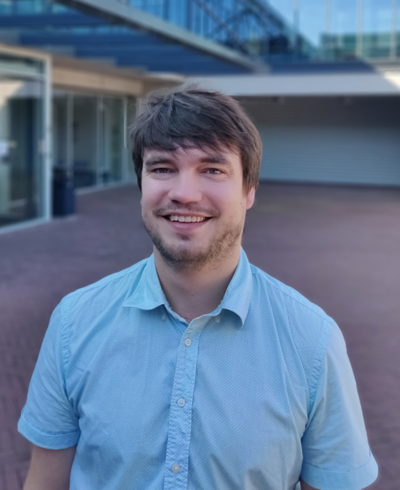high-dimensional quantum communication
Tristan Tentrup is a PhD student in the research group Complex Photonic Systems. His supervisor is prof.dr. P.W.H. Pinkse from the faculty of Science and Technology.
 In this thesis, Quantum Key Distribution and quantum communication methods based on high-dimensional spatial coding of light are developed. Their security is based on the fundamental quantum nature of light and profits from the high-dimensional Hilbert spaces offered intrinsically by imaging optics. An overview of classical information theory and quantum information is given to introduce the field of quantum cryptography. The advantages of larger dimensional alphabets and the security of the standard two-bases BB84 protocol is shown. The spatial states used for encoding are introduced. An analytic expression for the upper bound on the mutual information for these states is derived, including multiphoton states, detector noise and beam broadening. High-dimensional encoding of single photons is experimentally realized, reaching 10.5 bit per received photon. The dependence of the mutual information on the number of detector pixels is discussed and the experimental values are compared with the theoretical upper bound. It was shown that a standard error-correcting LDPC code is sufficient to achieve practically error-free communication. By adding a second mutually unbiased basis, a large-alphabet QKD system is experimentally realized and characterized. The security of this BB84-like protocol is analyzed in terms of intercept-resend and collective attacks. The key rate after postprocessing is analyzed under realistic circumstances, including finite key length. Finally, a new quantum communication method is demonstrated, which is based on encoding information into wavefronts decomposed over guided modes of a multimode fiber. At the end a step back is made and the similarities and differences of several quantum authentication and quantum cryptography schemes as well as Quantum Data Locking are discussed. This involves comparison of the characteristics of the classical channel, the quantum channel and the necessary dimension of the Hilbert space.
In this thesis, Quantum Key Distribution and quantum communication methods based on high-dimensional spatial coding of light are developed. Their security is based on the fundamental quantum nature of light and profits from the high-dimensional Hilbert spaces offered intrinsically by imaging optics. An overview of classical information theory and quantum information is given to introduce the field of quantum cryptography. The advantages of larger dimensional alphabets and the security of the standard two-bases BB84 protocol is shown. The spatial states used for encoding are introduced. An analytic expression for the upper bound on the mutual information for these states is derived, including multiphoton states, detector noise and beam broadening. High-dimensional encoding of single photons is experimentally realized, reaching 10.5 bit per received photon. The dependence of the mutual information on the number of detector pixels is discussed and the experimental values are compared with the theoretical upper bound. It was shown that a standard error-correcting LDPC code is sufficient to achieve practically error-free communication. By adding a second mutually unbiased basis, a large-alphabet QKD system is experimentally realized and characterized. The security of this BB84-like protocol is analyzed in terms of intercept-resend and collective attacks. The key rate after postprocessing is analyzed under realistic circumstances, including finite key length. Finally, a new quantum communication method is demonstrated, which is based on encoding information into wavefronts decomposed over guided modes of a multimode fiber. At the end a step back is made and the similarities and differences of several quantum authentication and quantum cryptography schemes as well as Quantum Data Locking are discussed. This involves comparison of the characteristics of the classical channel, the quantum channel and the necessary dimension of the Hilbert space.





